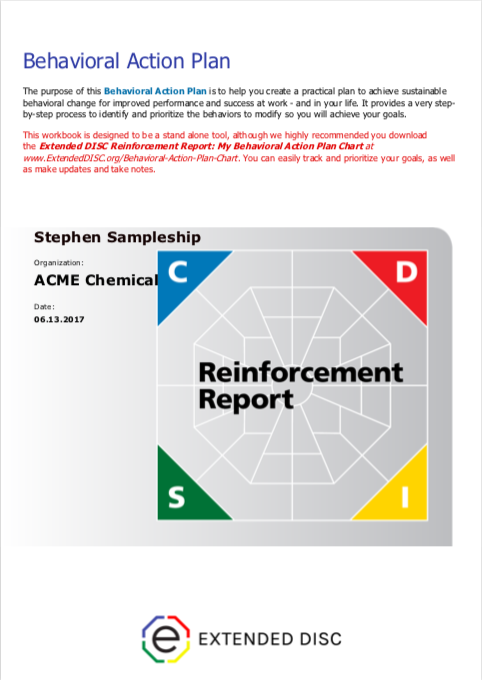Creating a practical behavioral action plan to achieve sustainable change improves your client’s performance at work and in life.
Your clients have successfully completed your DISC session and better understand their DISC profile results. It’s now time for them to roll up their sleeves and apply what they’ve learned from your session and their DISC report. How do they transfer their knowledge and motivation into actual success? They will need opportunities to reflect on which behaviors they need to modify, and then practice the behavioral change. The Extended DISC® Behavioral Action Plan is designed to help your client navigate this process.
We understand you wear many hats as a coach, so we focus on making things as simple as possible for both you and your clients. There are no additional questionnaires for your clients to take to generate this reinforcement workbook; you simply access your clients’ DISC profiles in your database. In addition, there is no set time frame for delivering the report to your clients; you determine the best time for your clients to receive their reinforcement workbooks.
Behavioral Action Plan
 Your client likely recognizes the value of an action plan, but getting started may be the issue. We need to help our clients identify their goals so they can lay out a clear plan. However, as coaches and trainers, we don’t always have an opportunity to work with our clients directly. Which is another reason why a focused, independent, and simple tool is essential for your client to build sustainable success.
Your client likely recognizes the value of an action plan, but getting started may be the issue. We need to help our clients identify their goals so they can lay out a clear plan. However, as coaches and trainers, we don’t always have an opportunity to work with our clients directly. Which is another reason why a focused, independent, and simple tool is essential for your client to build sustainable success.
The Behavioral Action Plan is a part of the Extended DISC Reinforcement Report series. Each focused workbook is designed to help your client continue building on their DISC learning. The Behavioral Action Plan helps clients identify where they want to go and how they plan to get there. They avoid costly detours and increase likelihood of success by identifying the most effective goals to focus their efforts.
The action plan serves as a guide, by providing a step-by-step process to identify and prioritize the behaviors to modify in order to achieve their goals. Without goals, we lack direction in our efforts and cannot determine if we have truly succeeded. It’s a dynamic workbook; therefore, your clients should review and update their goals and plans often. They can use it to monitor their progress and track their successes.
The simple steps for the Behavioral Action Plan include identifying and categorizing their behavioral goals. The final step toward implementation is to determine the specific behavioral adjustments needed to achieve their goals.
Behavioral Action Plan Steps

The first step is to write down their goals. Remember, the Behavioral Action Plan focuses on goals that are reachable through behavioral adjustments. While skills are very important, this Behavioral Action Plan will only focus on behavioral goals. The next step is to prioritize the behavioral goals as high priority, medium priority, or low priority. Your clients should consider how important each goal is to their current success. Also, focus on the goals that will help them to reach success the fastest, or will have the greatest impact on their productivity.
The next step is to further classify their high prioritized goals into three main categories, based on the potential behavioral adjustments required to achieve each goal. Which adjustments require your client to make overall modifications to their behavior? For example, if they are an I- style, they may decide to work on listening actively and talking less in all aspects of their business and personal life. Which goals require behavioral adjustments for specific situations? For example, if their goal is to close more sales, and they are an S-style, they may need to be more assertive for brief moments during the sales call. The third category are adjustments involving a specific individual. For example, they may want to communicate better with their boss.
Now they’re ready to create their Behavioral Action Plan based on their fully prioritized goals. Typically, the act of adjusting requires some increase and decrease of their DISC styles. They will determine which DISC style(s) to adjust for each goal. For example, do they need to emphasize their D-style and/or deemphasize their C-style to achieve the goal? They will further determine what specific behaviors they will practice and consciously adjust to help achieve the goal.
Additional benefits and tips
 The Behavioral Action Plan has each of the steps built into the workbook. However, there is an optional Behavioral Action Plan Chart that can be downloaded to follow the process. The benefit of the dynamic Excel chart is it can be constantly updated and modified.
The Behavioral Action Plan has each of the steps built into the workbook. However, there is an optional Behavioral Action Plan Chart that can be downloaded to follow the process. The benefit of the dynamic Excel chart is it can be constantly updated and modified.
Individual Assessment results are built into the Behavioral Action Plan to help your client customize their modifications. They will revisit their attributes, strengths, motivators, etc. to make it easier to create a successful Behavioral Action Plan.
It is important to recognize and celebrate the positive impact and hard work clients put into their behavioral adjustments. Use the Notes section to keep track of the times they’ve made adjustments and describe the outcomes. Consider if there was a personal impact, a relationship impact, a monetary impact, etc.
Remind your clients to reevaluate their goals by adding new ones and removing completed ones. When they stop adapting and adjusting, they will start to stagnate and possibly fail. As their situations, priorities, or careers change, so should their goals.
Putting it into Action
 They are ready to implement their plan of action once they’ve determined the goals which will bring the highest and most immediate successes. They’ve clearly processed and laid out a plan of action they’re accountable for. Remind your clients to constantly evaluate their adjustments; even adjustments need adjustments sometimes! This is not a set of rigid rules to follow, but a constant process of adjustments!
They are ready to implement their plan of action once they’ve determined the goals which will bring the highest and most immediate successes. They’ve clearly processed and laid out a plan of action they’re accountable for. Remind your clients to constantly evaluate their adjustments; even adjustments need adjustments sometimes! This is not a set of rigid rules to follow, but a constant process of adjustments!
Ultimately, your clients should be comfortable with who they are. Behavioral adjustments are often very brief, but the opportunity for a successful interaction is great. The goal is not trying to change who they are; rather, it is to change their behaviors. Now, they’ve laid out a road map template to continue their success.
Contact us to find out more about the Behavioral Action Plan and other Reinforcement Reports: +1.281.298.6073
